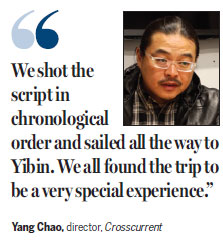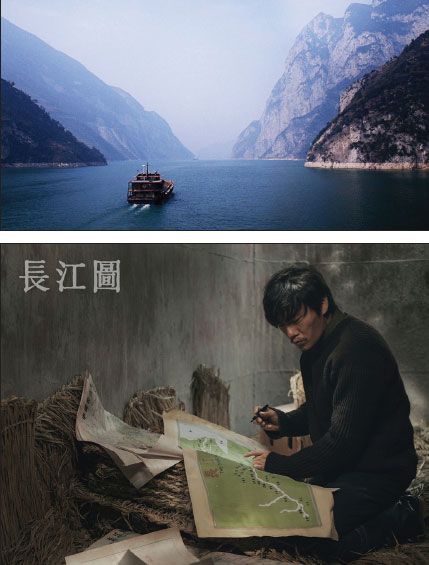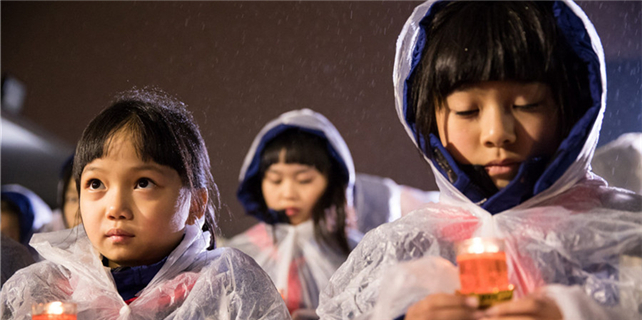Along the Timeless river
A filmmaker explores the magic of the Yangtze River

For Chinese people, the Yangtze River doesn't just exist physically, it is a river of time. It exists in China's history, said Yang Chao, director and scriptwriter of the new film Crosscurrent.
A blend of water imagery, fantasy, poetry and history, the award-winning film is now showing in the US.
It all happens along the ever-flowing Yangzte, from the megalopolis of Shanghai to the snow-capped mountains of Tibet, where Gao Chun sails his cargo ship up the Yangtze, going back in time and becoming more and more intrigued by An Lu, a beautiful woman who appears in different guises at each port.
After passing a pagoda that still echoes with the Buddha's voice, a flooded town reappears alongside the Three Gorges Dam and other transformed places - after which he finally arrives at the source of the Yangtze, where the secret of An Lu is finally revealed.
Filmed by Mark Lee Ping-Bing, Crosscurrent won the Silver Bear Award for cinematography at the 66th Berlin International Film Festival in February.

Yang has said that the Yangtze River has been portrayed by countless artists and writers for centuries. What he has tried to capture is the grandiose, supernatural and sublime side of the Yangtze that belonged to the Tang and Song dynasties.
"A daring mix of realism and lyrical fantasy," commented CineVue. "Rarely has China's explosive economic growth been captured with such grace and with such a heavy heart."
"Strongly affecting landscapes that seem to leap out of Chinese painting," said Hollywood Reporter.
Born in 1974 in Xinyang in Central China's Henan province, the director has had a special affinity with water since a very young age. He still remembers how he envied people who played in the river flowing through his hometown because he didn't know how to swim.
He didn't do well in the gaokao (China's college entrance exam), so he spent a year in a transitional program at the Wuhan Railway Television College and got into Beijing Film Academy.
At the time, the hallway outside of his classroom had a view of the Yangtze. Seeing such a grand river deeply impressed Yang and he became obsessed with the wide surface of the water.
After becoming a director, Yang first shot the Yangtze River in two scenes from his 2004 film Passages. He then decided his next film might be about the Yangtze.
In 2005, Yang started writing a draft and shooting footage of the Yangtze, even though he didn't have a clear story in mind.
But by the end of 2008, when Yang traveled to the Yangtze River again, he knew exactly what he wanted to do.
He dropped everything and started working on the script. By 2010, he had been through seven rounds of rewrites.
The first round of production started in January 2012 and lasted 63 days.
|
Sailing through the ages, the new film Crosscurrent takes viewers to a China few people ever get to see. Stills from the film Crosscurrent . Photos Provided to China Daily |
In the finished film, 80 percent of the scenes were shot on the Yangtze River, even though shooting while sailing on the river was more challenging than Yang originally thought it would be.
The crew used three ships: The Guangde, the cargo ship shown in the movie, a second ship for the cameras to shoot from and a third ferry that the cast and crew lived on.
"We set off from Shanghai (where the Yangtze flows into the East China Sea). Everyday, we just stopped the cargo ship somewhere along the river, shot some footage, sailed away and repeated," Yang recalled. "In this manner we shot the script in chronological order and sailed all the way to Yibin. We all found the trip to be a very special experience."
The film was shot in winter, because Yang wanted to show a stern-looking Yangtze in cold colors like those in traditional Chinese paintings.
"It was freezing on the Yangtze River in January. We had to get heat from burning fuel on the cargo ship. That drove our producer crazy. He would turn off the heat after midnight. Then someone would wake up shouting 'It's freezing!' around 2 in the morning," Yang said.
It costs a lot to shoot on the water. The crew ran out of money around Luzhou and was dismissed there.
In November 2013, with the additional investment they got, Yang spent 20 days shooting more footage, including the snowy mountains of Tibet, which is the source of Yangtze River.
After three rounds of editing, the film was shown in Berlin in February.
After returning to China, the team spent more funds to rescan the film and make a 4K version.
"It shows the audience a China they have never seen before," said Yang.
xiaohong@chinadailyusa.com










